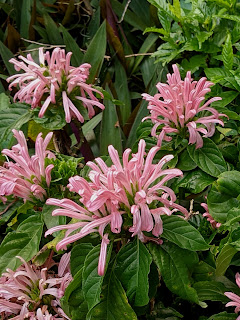Best, and most, common names ever: Burma Creeper, Madhavi lata, Chinese Honeysuckle, Irangun malli, Ishq peccan,
et alia. I read at some point after we planted it that this is the most popular/commonest vine in Delhi. I can believe it. It's got so many virtues. It's vigorous (more on that later), it's fragrant, it's pollinator friendly though possibly more so in its native habitat than here (it does attract certain moths in our garden, it flowers for at least 8 months for us in Central Florida, it seems to be pest and disease free, I never water it at any point in our, occasionally 8 month, dry season. Wow it's like a perfect plant. I have read that some people find the fragrance unpleasant, but smells are like that. I enjoyed the scent when I could smell it. I was never diagnosed with Covid, but a couple of years ago, I lost the ability to smell certain flowers and this is one of them. Oh well. Before I forget, the plant is highly regarded by
Feng Shui designers being considered indicative of abundance and prosperity.
We have been watchin Good Karma Hospital for a few weeks; it's filmed in Sri Lanka, not Delhi, but there's plenty of Drunken Sailor in the backgrounds. Last night, the plot featured a drunken, maybe he was a sailor... It appears to be native to a wide range of tropical East Asia possibly even stretching around the Indian Ocean to Easter Africa. Undeniably a beautiful plant though its color, white flowers aging to red, and its relentless exuberance may make it more suited to some gardens than others. We love it.
As to invasiveness, I can say that in 5 years we've not seen seeds or seedlings but apparently it can, and is, a problem in South Florida. The flowers are hermaphroditic so, barring physiological or timing issues it could be self fertile. After a limited search all I could find on the subject is that there seems to be some level of self-incompatibility. So maybe if you have only one plant you're safe. Of course that's only if your neighbors don't have a compatible individual. It's hardiness is generally listed as 10a or 9b and we are securely 9a. There's a list of plants that are hardy in 9b that we lose regularly. I'd lose to grow Sea Grape, Coccoloba, that is very comfortable in Tampa, but no... Maybe I'm being unduly optimistic about chances of it escaping but I weed relentlessly and identify all seedlings especially new ones. Still, I wouldn't plant it in South Florida so we're going to keep it.
















